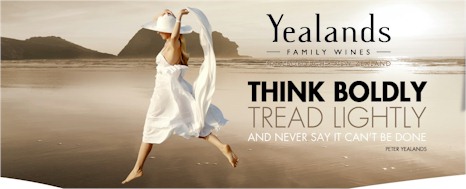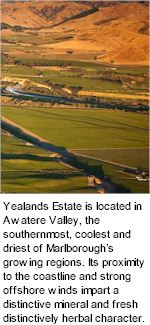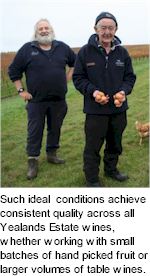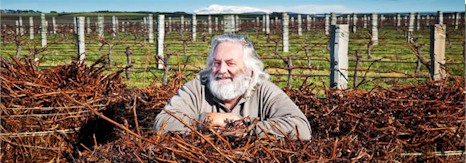


Aesthetically, the building is designed to blend into the landscape with no disruptive contours. Rainfall from the roof of the winery is collected in swale drains on either side of the building, and either recycled or piped out to our wetlands. Throughout the building, motion sensors control lighting and air conditioning, ensuring neither is left on needlessly. Extensive insulation and heat recovery technologies reduce heat loss and recycle energy for re-use. Probes inside and outside the building maintain constant temperatures while solar panels, wind turbines and the burning of vine prunings generate supplementary power. The goal is to become self-sufficient in energy, supplying surplus power back to the national grid.

Yealands Estate is located in Awatere Valley, the southernmost, coolest and driest of Marlborough’s growing regions. Its proximity to the coastline and strong offshore winds impart a distinctive mineral and fresh herb character. Whilst geographically diverse, Marlborough's maritime climate, long cool growing season, and young fertile soils promote intense varietal characters, fresh natural acidity and succulent ripe fruit flavours that the world has quickly embraced. The unique combination of soil, climate and water, innovative pioneering spirit and commitment to quality, all come together to deliver pure, intense and diverse wines brimming with flavour. Such ideal conditions achieve consistent quality across all Yealands Estate wines, whether working with small batches of hand picked fruit or larger volumes of table wines.
Peter Yealands carries a trademark can-do attitude that's the stuff of legend. Happiest working the land at the controls of a bulldozer or digger, Yealands has a track record of making pioneering, innovative plans come to fruition. Peter, wife Vai and son Aaron now focus their energies on building Yealands Estate into a global brand.
Yealands has developed seven of his own vineyards in Marlborough, plus several others under contract for other companies. His entrepreneurial vision however extends well beyond grapes. He was issued with New Zealand’s first marine farming license in 1971 for the harvest of green lip mussels. Thanks to his efforts in designing innovative technologies and helping establish aquaculture in the region, marine farming now contributes $160 million a year to New Zealand’s export earnings.

Yealands Estate vineyards are all fully accredited through the Sustainable Winegrowers New Zealand programme. Other environmental auditing initiatives include carboNZero certification and ISO14001 environmental management systems accreditation, providing a measurable and accountable method for review and improvement of sustainability practices.
Wine production is an energy intensive business, the juices needing to be warmed, prior to fermentation and bottling, and cooled for storage and stabilisation, throughout the winemaking process. The application of cutting edge technology, insulation and general work practices, all combine to make Yealands winery three times more efficient in energy utilisation than the New Zealand wine industry standard. The winery's power and water heating is supplemented by wind turbines, solar panels and grape vine prunings. The addition of a third, larger turbine, will realize the goal of being completely energy self sufficient. The large winemaking area contains tanks of varying sizes. From their laboratory on the mezzanine floor overlooking this, the winemakers are able to control temperature of each tank separately and precisely. Besides aiding the sustainability drive, this permits monitoring each batch of wine with absolute precision.
Peter Yealands recently won the prestigious Lincoln University Foundation South Island Farmer of Year award for 2013. The Yealands entry stood out for its innovation, entrepreneurship and vision. Yealands also won the Silver Fern Farms Plate to Pasture award for consumer awareness, and the Lincoln University award for best use of technology and innovation. Peter's philosophy of thinking boldly and getting things done, also demonstrates innovation inside and outside of the winery. Sound business practices are integrated into every aspect of the operation, in complete concert with a holistic vine to bottle approach.
